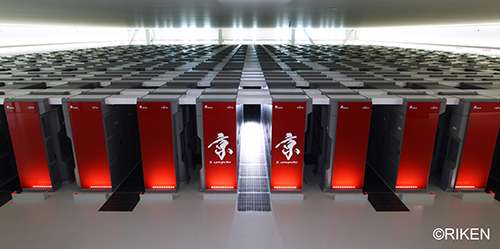January 14, 2014 weblog
K computer is unleashed for largest neuronal network simulation ever

(Medical Xpress)—Wow, today's top supercomputers have formidable speed and computational power to rival humans. On the other hand, wow, the human brain is more powerful than today's supercomputers, which with all their calculations, cannot surpass the complex wonder called the human brain. Scientists note that the brain, the basis of behavior and mental activity, is where over 50 billion neurons communicate with each other, in a network of complexity that some called "unimaginable." Each individual neuron's performance depends on molecular structures and mechanisms, and connections and spatial location in the brain.
A team of scientists from institutions in Japan and Germany have proven both "wows" are true. A report in this week's The Telegraph discusses the feat of a team from Japan and Germany who carried out a record simulation of the human brain, in the largest neuronal network simulation to date—and yet achieved a model of only one second of human brain activity, and taking the computer 40 minutes to do so. Consider: a single second's worth of activity took one of the world's largest supercomputers 40 minutes to calculate, and involving just one per cent of the neuronal network in the human brain. The joint project was carried out by the Japanese research group RIKEN, the Okinawa Institute of Science and Technology Graduate University and Forschungszentrum Jülich, a Germany based research center,
The team used RIKEN's K computer, which has its home in Kobe, Japan, known for exceptional precision and computational power and also ranked as one of the world's most-powerful supercomputers, to simulate human brain activity. (The K computer was officially made available for use by researchers in September 2012.)
The team made use of the open-source Neural Simulation Technology (NEST) tool. The NEST project site describes it as a simulator ideal for networks of spiking neurons of any size. NEST was put to work to replicate a network of 1.73 billion nerve cells and 10.4 trillion synapses.
While only a second's worth of brain activity was achieved in 40 minutes, the project team nonetheless values their effort, as the goal was not to compete with or discover something entirely new about the brain but rather to test simulation technology and the capabilities of the K computer.
According to RIKEN's announcement, the researchers came away with knowledge that can guide the construction of new simulation software. Their work, said RIKEN, also "offers neuroscientists a glimpse of what can be achieved by using the next generation of computers—so-called exascale computing."
Markus Diesmann of Forschungszentrum Jülich's Institute of Neuroscience and Medicine, said, "If petascale computers like the K computer are capable of representing one percent of the network of a human brain today, then we know that simulating the whole brain at the level of the individual nerve cell and its synapses will be possible with exascale computers—hopefully available within the next decade."
More information:
www.telegraph.co.uk/technology … -brain-activity.html
www.riken.jp/en/pr/press/2013/20130802_1/
© 2014 Medical Xpress

















